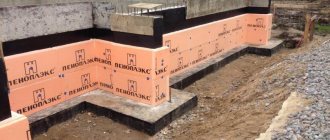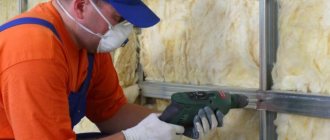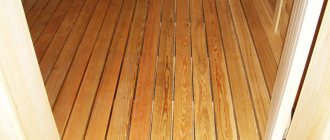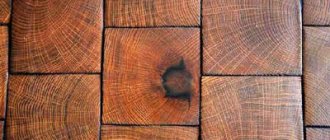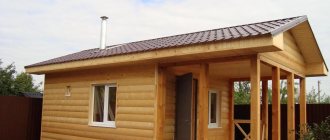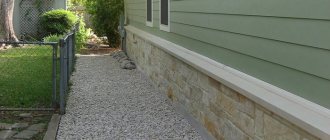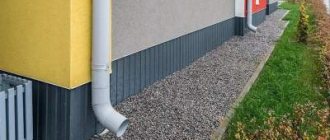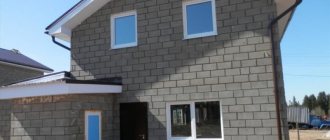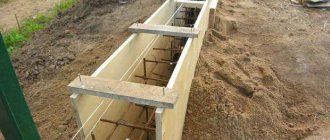Wooden baths have been built in Rus' from time immemorial and did not require additional insulation. However, previously the householder himself could harvest the wood, dry it, process it, and set up a bathhouse. Today you have to trust third-party companies, so shortcomings only emerge during operation. And if the tree turns out to be unable to retain heat, you need to think about additional insulation.
In this article we will talk exclusively about the insulation of wooden walls, because the rest (floor, ceiling, roof, attic) have already been discussed in other articles on the site; insulation for the ceiling, among which clay and its mixtures especially stand out, are also analyzed separately.
The choice is always yours, we only undertake to talk in detail about what is needed for this and how it is carried out.
Construction, insulation and finishing of the steam room, what you should pay attention to
If the time has come to build a bathhouse, then first you need to design the placement of the steam room, then decide on the finishing option, and, based on this, insulate the room.
Steam room arrangement
Planning is the simplest stage in construction, but it is at this stage that it is necessary to take into account all sorts of nuances that may arise in the process.
When designing a steam room, take into account:
- the number of people who can simultaneously steam in it;
- type of heating furnace.
Based on this, the area of the room, the distance between the shelves, their distance from the stove, the placement of ventilation and much more are calculated.
If the task of how to make a steam room in a bathhouse with your own hands according to all the rules turns out to be backbreaking work, then it is better to contact the designers, or choose a standard layout option. For example, a steam room with an area of 2 m wide and 2.4 m long, with a ceiling height of no more than 2.2 m, can accommodate up to three people.
A room of 2.5x3.0 can easily accommodate 4 people Source www.skvb-nn.com
Steam room interior decoration
Typically, wooden lining is used for cladding a steam room; the only difference is the nature of the material. Of course, you can make the lining with plastic, but this is a short-lived material if used in high temperature conditions. Plus, when exposed to hot air, plastic can become a source of toxic substances, so spending time in such a steam room will not only be uncomfortable, but also dangerous.
The following wood species are considered the correct cladding material: linden, aspen, alder, larch. The lining made from them is quite heat-resistant and does not deform under prolonged exposure to hot steam. Each of them gives off its own individual smell.
Do not use wood containing resin. When exposed to high temperatures, a heavy odor will be released, and drops of resin will appear on the surface. If you really like the smell of a coniferous forest, you can take tree branches or pine cones with you to the steam room.
When purchasing material, pay attention to the presence of defects such as cracks and knots. There shouldn’t be any, otherwise when heated, the cracks will only expand, and the knots will even fall out, forming a through hole.
Cladding walls with clapboard Source provagonky.ru
Insulation
Next, we’ll figure out how to make a steam room in a bathhouse correctly and why insulate the steam room from the inside. Typically, the material for making a bathhouse is timber, less often brick or concrete. If you do not line the inside of the steam room with mineral wool and clapboard, then in the process of creating hot steam it will be necessary to warm up the supporting beam or brickwork. For example, to heat the air in an uninsulated steam room to 100 degrees under the ceiling, 120 kW is needed. An hour of warmth. Provided the steam room is insulated from the inside, only 15 kW will be needed for heating. An hour of warmth. Obviously, it is worth doing insulation, but how to insulate the steam room from the inside is still an open question.
Scheme of thermal insulation of walls with mineral wool followed by clapboard cladding Source masterfasada.ru
Properties to insulate attention
Before insulating a steam room in a bathhouse from the inside, before covering it with clapboard, you should figure out which material is suitable for these purposes.
Insulation for a steam room must have the following properties:
- Moisture resistance. Since the steam room is a place with a high concentration of moisture, the material must be inert to the effects of water and, if possible, vapors, otherwise it will get wet and lose its qualities.
- Temperature resistance . Since the steam room is a place with a high concentration of moisture, the material must be inert to the effects of water and, if possible, vapors, otherwise it will get wet and lose its qualities.
- Safety . When heated, the insulation should not emit harmful substances.
There are a lot of options for how to insulate a steam room in a bathhouse. For example, it is preferable to insulate the walls and ceiling inside with basalt or stone mineral wool. To increase the moisture resistance of the insulation, aluminum foil or ready-made thermal insulation material with a foil layer is used. For horizontal surfaces (floor, attic), preference is given to bulk materials perlite or expanded clay.
Laying mineral wool with a foil layer Source provagonky.ru
Comparison of the vapor permeability of some materials (10 (-6) kg/m x sec x atm):
- aluminum foil – 0;
- glass – 0;
- steel – 0;
- polyethylene films – 0;
- polystyrene foam – 0.1;
- pine board – 2;
- expanded clay concrete – 3;
- mineral wool – 7.
As you can see, mineral wool, while having good thermal insulation properties, has practically no vapor barrier properties. To correct this, use a vapor barrier, for example, aluminum foil or mineral wool with a foil layer on one side. Although polyethylene films have zero vapor permeability, they, having a low temperature threshold, are not suitable for use, since they emit an unpleasant odor when heated.
An example of materials for insulating the walls and ceiling of a steam room Source legkovmeste.ru
See also: Catalog of bathhouse projects
Floor insulation.
Let's figure out how to insulate a steam room so that the high air temperature lasts long enough. To do this, it is necessary to eliminate all possible heat leaks. And you have to start from the floor. In winter, the ground freezes to a depth of an average of 1 m (depending on the region of residence), therefore, the better the floor is insulated, the less heat loss will be through it.
To insulate the floor, a hole is dug around the entire perimeter of the steam room, at least 60 cm deep relative to the level of the finished floor. The bottom of the pit is lined with a sand cushion 5 cm thick. The next layer is a thermal insulation material, for example, polystyrene foam, 20 cm thick. Then 2 layers of cement screed with expanded clay, 5 cm each. And a finishing screed made of concrete grade M 200, reinforced with a mesh with a cell width of 10 cm. When pouring concrete, a slope is formed towards the sewer drain.
After 14 days (the time required for the concrete to fully set), the plank floor is laid.
Spillproof floor. Laying process Source i.pinimg.com
Ceiling insulation
Let's look at how to insulate the ceiling in a steam room of a bathhouse from the inside and outside, from the attic side.
Regardless of what material the ceiling is made of - reinforced concrete slabs or wood, the ceiling of the steam room must be additionally insulated.
A vapor barrier film is spread along the perimeter of the ceiling, overlapping the walls, pressing it against the surface of the slab with wooden blocks 100x100 (mm), the distance between them is 50 cm, or otherwise depending on the width of the insulation boards used. Basalt mineral wool 10 cm thick is laid between the bars. The main vapor barrier is rolled out from foil, which is pressed with clapboard. The optimal thickness of wooden cladding is 10 mm; nails with flattened caps are used to fasten the lining.
The ceiling outside (in the attic) is also subject to insulation. To do this, roll out waterproofing material over the surface and lay a layer of expanded clay 15-20 cm thick.
Bulk insulation (expanded clay) in the attic of a bathhouse Source static-eu.insales.ru
Selecting a skin
Is it possible to cover a steam room with plastic rather than wood? Yes. But steaming will not be comfortable. Not even any type of wood is suitable for such premises. Preference is given to linden, alder, aspen and abash. When heated, such wood maintains a temperature close to 36 degrees, does not darken, and does not burn human skin. After steam treatment, a pleasant smell specific to each tree is released. The choice of wood depends only on the taste of a particular person.
Lining with foil in the steam room
Article on the topic - penofol insulation.
To preserve the characteristic properties of the finish, each element is necessary in advance:
- Cut to size;
- Plan, rounding the corners of the workpieces;
- Sand, drilling the fastening points with nails;
- Impregnate with a solution (borax, sodium fluoride);
- Dry at a temperature of 60 degrees until the humidity does not exceed 10 degrees;
- Saturate the brush generously with a water-repellent compound (heavily diluted PF varnish).
Thermal insulation of steam room walls
Let's look at how to make a steam room in a bathhouse so that the heat lasts longer. To do this, it is necessary to create the effect of a thermos and insulate not only the horizontal structures of the room, but also the vertical ones. The work algorithm is similar to insulating the ceiling from the inside.
It must be taken into account that a wooden bathhouse made of timber in the first two years of operation shrinks up to 20 cm, depending on the frequency of use of the building. Therefore, when calculating door and window openings, you need to make a height reserve of up to 20 cm, and when insulating walls, use special structural elements.
The first thing to do is to prepare the surface before insulation, clearing it of debris, dirt and dust.
Second, the formation of a wooden frame for the subsequent laying of thermal insulation material. To do this, a sheathing is formed from bars 5x5 cm or 6x6 (depending on the thickness of the insulation) in increments of 50 cm.
If the clapboard cladding is “horizontal”, then the sheathing is done vertically, and vice versa, with “vertical” clapboard cladding, the sheathing bars are stuffed horizontally.
The third stage is laying a vapor-waterproofing film (it is better to use a stapler to secure it) and insulation.
The fourth stage is vapor barrier with aluminum foil, the joints of which are glued with metallized tape.
High thermal insulation characteristics
Two features make LOGICPIR insulation most effective:
- record low thermal conductivity coefficient of 0.022 W/m•K;
- high reflection coefficient - from 95 to 98%.
The material belongs to the class of reflective thermal insulation - it fully complies with the requirements of GOST R for reflective thermal insulation. That is, it allows you to retain radiant heat from the stove, save its energy, effectively reduce heat loss in the room, and at the same time does not absorb moisture at all.
Making a steam room in a bathhouse correctly and beautifully
Let's figure out what it means to do it beautifully, and how to make a steam room in a bathhouse correctly.
Area calculation
A properly made steam room is directly responsible for the safety of bathing procedures. Therefore, you should not neglect calculations when designing a steam room and bathhouse as a whole. The size of the room must be calculated not only from the point of view of cost savings to create the desired temperature. It is necessary to take into account the possibility of servicing heating elements, ventilation shafts, as well as the ease of using the bathhouse.
If the floor is made of wood...
Wooden floors in bathhouses are much more common, although concrete floors are better in performance. But wood always attracts attention due to its naturalness, environmental friendliness, and preservation of heat in the room.
When properly treated with various means, such coatings can last for a long time. Wood floors are very similar in construction to concrete subfloors, but instead of floor slabs, they are built on beams. The insulation material is placed above the subfloor, and slag, mats, mineral wool, and sand can be used in this capacity.
It is very popular today to insulate the floor of a wooden bath with Penofol..
It is a multilayer material with good reflective insulation properties due to the foil base and polyethylene foam. The peculiarity of the material is that it can be used for finishing baths even in harsh climatic conditions.
Video description
All of the above points have already been taken into account in standard bathhouse designs. What they are, see in the following video:
Hire a specialist or do it yourself
How to insulate a steam room in a bathhouse: a comparison of options for hiring an experienced professional and working independently.
The main advantages of building a bathhouse and insulating a steam room with your own hands:
- Saving money for paid labor, or rather for its absence. After all, all the work is done by the owner himself.
- Total control, from the purchase of materials to installation, again due to the fact that everything is done independently without the involvement of third parties and organizations.
The main disadvantages of DIY construction:
- Time. Without working skills and not knowing design standards, it will take a lot of time to study this issue.
- Speed. The work that a specialist can do in a matter of hours, an inexperienced person will do for several days, so that the quality is at a high level.
- Inflated prices when purchasing materials. As a rule, when purchasing materials in bulk, you can save up to 50% of money. This is what organizations working on a turnkey basis take advantage of, purchasing material for several objects at once.
Mineral wool is used to insulate steam room walls, lining is used as a facing material Source banyaportal.ru
Beauty is in the little things
As a rule, making a steam room in a bathhouse beautiful is not as difficult as it seems at first glance. The interior decoration of the walls, ceiling, floor, arrangement of shelves and lighting elements are primarily responsible for presentability in the steam room.
To finish the walls, ceiling and floor, lining of different types of wood is used. You can also combine wood finishes with tiles and stonework.
An example of finishing a steam room No. 1 Source brodude.ru
Key points for insulating a steam room in a wooden bathhouse
Wooden structures shrink during the first years, so it is better to start insulating the bathhouse and carry out interior finishing work 1-2 years after the installation of the log house. If you neglect this rule, then after a year cracks will appear in the walls of the bathhouse, which will have to be carefully caulked, sometimes more than once.
If you decide to insulate yourself, then you need to draw up a sequence of work and impeccably follow all the points of existing rules and instructions on how to properly make a steam room in a wooden bathhouse.
A steam room insulated according to all the rules is a thermos, which is why, in addition to insulation, when carrying out work, steam and waterproofing materials are used, which not only increase the service life of the material, but also increase its thermal insulation properties.
Structure of the thermos steam room:
- load-bearing wall or partition;
- waterproofing;
- thermal insulation;
- vapor barrier;
- interior decoration.
How to properly insulate a door
Door insulation technology
Large heat losses occur through door cracks, so you must take care of the thermal insulation of the wooden or iron door leading to the bathhouse.
Felt, basalt wool, and foil insulation can be used as insulation. There are several ways to insulate a door; below we present the most common:
- A frame of 15x20 mm slats is mounted around the perimeter of the door, which should be 10 cm away from the edge of the door leaf.
- A piece of hardboard is placed inside the frame and stapled.
- Felt or other material is pulled over the top of the frame and secured with nails, which should be 5 cm larger than the frame itself.
Video description
The insulation of a bathhouse from the inside is clearly shown in this video:
Insulation materials
There are many thermal insulation materials on the market that are suitable both for insulating a steam room and for insulating other buildings. Therefore, among them it is worth highlighting those that are suitable specifically for interior work in a bathhouse.
It is worth paying attention to the following characteristics:
- increased fire resistance;
- low thermal conductivity;
- resistance to damage by rodents and insects.
Mineral wool is most often used; it not only meets all of the above properties, but is also easy to install, which is important when faced with the task of making a steam room in a bathhouse with your own hands.
There are no special requirements for waterproofing films. But with regard to vapor barrier - yes. Aluminum foil is a cost-effective option, both in terms of cost and installation work. In order for the foil to work correctly, it is necessary to properly insulate the room by gluing all joints with aluminum tape.
Sources of heat loss
At first glance, the window in the steam room is an extra item, but the room with it looks much more comfortable and presentable. To prevent heat from escaping from the room, you need to install the window correctly and use a two- or three-chamber double-glazed window. Therefore, it’s up to you to decide how to make a steam room with or without a window.
Quite a lot of heat can escape through the window in the steam room Source tovarim.ru
Option for insulating a bathhouse complex from the outside
Sealing seams is a mandatory process when insulating.
There are many ways to protect a building from the negative effects of the environment, but a system of ventilated facades is rightfully considered one of the most effective. This is an ideal solution for rooms with high humidity, because this design boasts not only excellent energy-saving functions, but also high vapor permeability.
Important! Any work on insulating a new bathhouse can only begin after the building has completely settled; this process takes on average no more than six months.
When preparing for work, first of all you need to take care of the insulation. Experts recommend using mineral fiber-based slabs in structures with ventilated facades.
Particular attention should be paid to the corners of the building, because it is through them that the most heat is lost - reduce the number of joints in this area as much as possible!
Do you want to know how to do everything strictly according to technology? See instructions:
- Prepare the walls - the process begins with a thorough cleaning of the surface, after which it is necessary to caulk the seams, and at the end treat the walls with an antiseptic. If rot is detected, the log is rehabilitated or replaced if the defect is severe.
- Install the brackets - they are installed on top of a layer of poranite or roofing felt.
- Install the sheathing panels on pre-prepared fasteners - they can be made from galvanized profiles or timber with antiseptic impregnation. The first option is less susceptible to deformation, but in cold weather it acts as a conductor of cold, so it would be more advisable to give preference to wood.
Advice: when assembling the frame, take into account the size of the insulation, and also take into account the required margin between the insulation layer and the edge of the wooden structure, it should be at least 2 cm!
- Place the insulation into the resulting cells - you can prevent the material from falling out with additional fixation with disc dowels.
- Cover the structure with a windproof superdiffusion membrane - only a vapor-permeable film is suitable, which does not allow moisture to accumulate under the skin.
- Finally, cladding is carried out with facing material.
Another option for the correct outdoor “warm pie”
Very often, in an attempt to save money, consumers strive to insulate a bathhouse only from the outside, even one made of logs. Is this right or wrong? The answer can be yes if the premises are located in a region where there are no harsh winters. Moreover, the material used for construction by and large does not play any role, the main thing is to carry out the work strictly according to technology. If in a village or city -20 in January is far from the limit, of course it is necessary to additionally insulate it from the inside!
What dangers await you if the steam room is not insulated correctly?
Sooner or later, the flaws of improper work will come out. There are only two main ones:
- Wrong choice of materials. As a result, you can get an unpleasant odor released by the material when heated, poor heat retention and, as a result, high heat and energy consumption.
- Violation of the tightness of the room. It is observed when the vapor barrier of walls and ceilings is incorrect. In this case, there will be a leak of steam, a decrease in heat and an increase in thermal energy consumption. Under the influence of hot air, deformation of finishing materials and internal structures of the building will occur. Steam turning into water will become a source of dampness, and subsequently an unpleasant odor and mold.
Briefly about the main thing
Particular attention should be paid to insulating the steam room from the inside. You need to start with the layout of the steam room, choosing the cladding option and insulation material.
Mineral wool is considered the best insulation; for the floor it is preferable to use expanded clay. Aluminum foil is used as a vapor barrier.
It is necessary to approach the process with great responsibility. Therefore, it’s up to you to decide how to make a steam room yourself or with the help of professionals.
Ratings 0
Floors
You need to start finishing with insulating the floor in the waiting room of a wooden bath. In this process, the choice of material plays an important role, since thanks to it the most comfortable temperature in the room will be maintained. Often, when treating the floor, foil polyethylene is used, which minimizes the temperature difference between the outside and the inside. External cladding can act as additional thermal insulation.
The floor in a modern bathhouse can be wooden, as was customary in the old days, or concrete. Accordingly, the methods of their insulation will vary significantly. Insulating the floor of a wooden bathhouse based on a concrete screed involves the use of perlite, glass wool or expanded clay, and these materials are laid between two layers of concrete covering. If the insulation is perlite, it is mixed directly with the concrete mixture.
Expanded polystyrene is a good alternative to these materials - slabs of different thicknesses are produced in different brands. The popularity of their use for finishing concrete floors is explained by their lightness, wear resistance, excellent thermal insulation properties and cost-effectiveness of use.

